Amy Arbus did not take photographs of circus performers until a year ago. But as soon as she started, she thought, “I know that I can do something interesting here.”
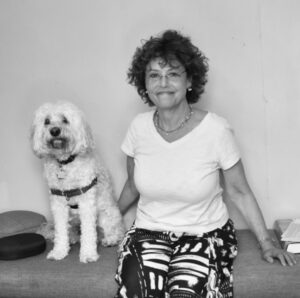
Arbus was in Provincetown last May — she spends summers here — when a friend took her to Hyannis to see Flip Circus, a small tent production of the Circo Hermanos Vazquez, which originated in Mexico City in 1969. She seems surprised to have found herself fascinated.
“My mom wanted me to be in the circus,” says Arbus. “I said, ‘Isn’t that dangerous?’ ”
There is something of that danger in her photographs. Her focus is on the performers as they fly through the air, their bodies fleetingly contorted. Arbus shoots the heat between moments, where performers’ skill and finesse turn risk-taking into art. “It’s the stuff you’re not conscious of seeing because it goes by so fast,” she says.
In The Fall, a performer hangs upside down. A beam of light comes from behind her, making the photo more dramatic. Her intricate garment is tight to the body, which hangs in the air. The performer’s hands and forearms are mid-movement, leaving us in suspense: Will she catch herself? What parts of her body will submit to gravity while others stay suspended in the air?
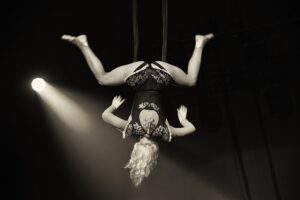
A performer swings away from the viewer in another of the black-and-white images. “I think it’s another fall,” says Arbus. “But I just called it The Flame because that’s what her hair looks like.”
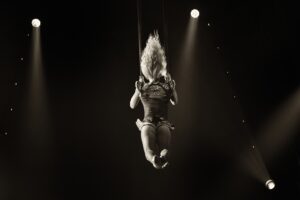
Arbus says she was searching for something similar photographing babies for one of her projects, which in 1999 became The Inconvenience of Being Born. “I was searching for the middle of the expression,” she says.
Over the past year, she has been photographing trapeze artists, acrobats, hoop divers, aerial dancers, burlesque dancers, and contortionists at dress rehearsals and live performances across the Northeast. If there was a circus act within 100 miles of her New York City home, she was there, she says.
Lately the series “is going more in the burlesque direction,” says Arbus. She recently photographed the performer Spookey, who lives in Provincetown, twirling on the lira, an aerial hoop.
“Each time I do a series I reinvent the way I do it,” she says. “I start to realize what the subject calls for. I look for things I haven’t seen before.”
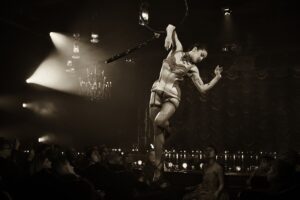
Photographs from her project “Beyond Reason” will be on view beginning June 14 at Schoolhouse Gallery in Provincetown. They are part of a group show with works by David X Levine, Jo Sandman, Han Feng, and Stephen Aiken.
Arbus first developed a following in the 1980s, with photographs published in the Village Voice. Her “On the Street” was ostensibly a fashion column for the weekly, but it was also something more. With those photos, photographer Frank Ward wrote, “Arbus helped mythologize the American street.”
Working for fashion photographer Jean Pagliuso, processing her film, booking models, and printing, was training for that job.
Arbus says she did not learn her art from her mother, photographer Diane Arbus. Her father, too, had been a photographer as well as an actor.
“Growing up I just thought, ‘Why bother?’ ” she says. “I didn’t feel the need to make pictures because my parents were doing it really well.”
Still, she was used to being around photographs. “Smelling them, looking at them, going with my mom to shoot occasionally,” she says. “Things get in by osmosis — there’s so much. There was no photography after she died,” she adds. “I really missed it.”
For a while, she tried to pursue music instead. She never finished high school, but she got a GED and enrolled at Berklee College of Music in Boston. It wasn’t right for her, though. “I was around all these musicians who were child prodigies,” she says. Good friends were in the band The Cars. “They could hear something on the radio, and they’d be playing it,” she says, and remembers thinking, “This will never happen for me.”
Arbus dropped out of Berklee and started taking pictures. “People knew I was a photographer before I was one because I described everything visually and then I realized they were right,” she says. “I do tell stories with visuals.”
Hilton Als, writing in the New Yorker in 2008, called Arbus’s photographs published that year in The Fourth Wall “her masterwork.” They are portraits of Broadway actors wearing their costumes in green rooms and on the street outside the theaters’ doors — still performing, in a way, but offstage.
Following circus people, Arbus has been struck by the intensity of the work. “When a performer has a bad day they think, ‘I’d better get with the program or I’ll break my neck.’ The stakes are high,” she says. “Their bodies are amazing, and their lives are insane — they’re traveling, and they work the cash registers, they seat people; everybody is doing everything.”
Even so, she could not find her angle behind the scenes. “I spent one intermission backstage,” she says, “but watching a guy reading a newspaper and a woman stretching wasn’t visually compelling.”
Arbus is much more interested in the theatrical moments on the circus set, “the gorgeous lighting and costumes.” In Upside Down, Arbus captures the surreal movements of a performer on a lira. The upper half of the performer’s body is inside the ring while the lower half is above it, suspended by pure muscle. Lines of sculpted quads are sent skyward. Straps cross the body. Pools of light are reflected by the performer’s costume.
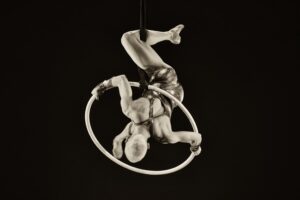
Photographing circus acts like this one can entail dealing with black light and dayglow colors, says Arbus, whose pictures are black and white. Arbus uses a Nikon ZA7II. “I had to switch to a mirrorless camera to be able to do what I wanted to do,” she says. She photographed the performers at 10 frames per second to capture the action.
In Strong, people are stacked on top of each other. One performer uses his head and upper back to balance on another performer’s thighs while using his arms to suspend a third performer in the air above.
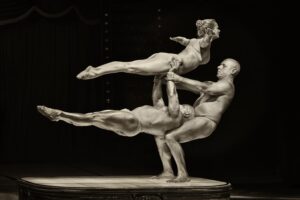
As they capture the flashes that are vital to performance, Arbus’s photographs become something else for the viewer: a reflection on how one maneuvers through one’s own existence.
Dangerous Moves
The event: Amy Arbus’s photographs of circus performers
The time: June 14 through July 16
The place: Schoolhouse Gallery, 494 Commercial St., Provincetown
The cost: Free
